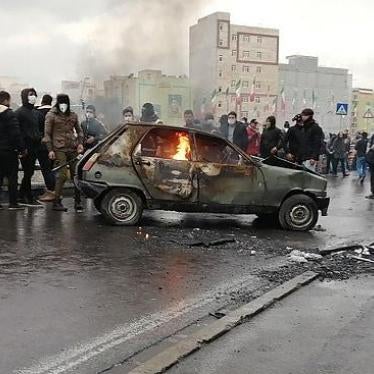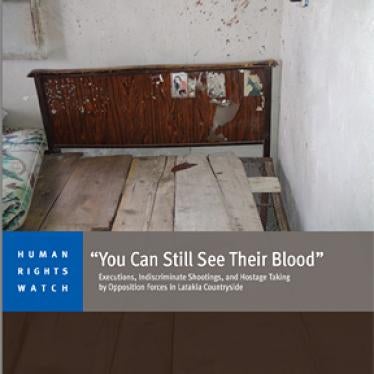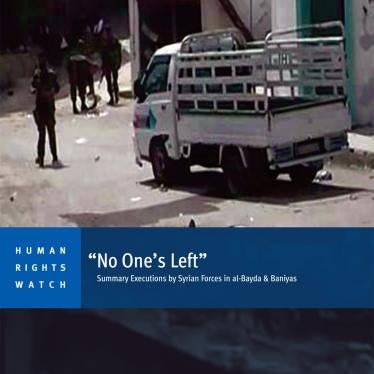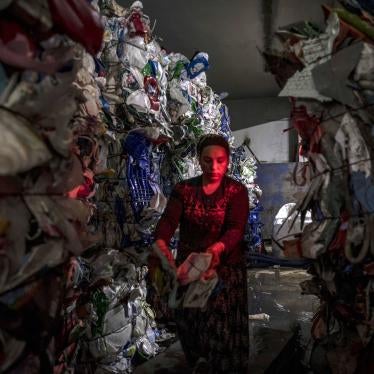(Misrata) - Libyan government forces have launched indiscriminate rocket and mortar attacks on residential neighborhoods in the rebel-held city of Misrata, Human Rights Watch said today. One strike, apparently by a Grad rocket, killed at least eight civilians waiting in line for bread. Another attack, apparently with a mortar round, hit a medical clinic, wounding four others.
At least 16 civilians have been killed in indiscriminate attacks since April 14, 2011, Human Rights Watch said, based on witness and survivor accounts, as well as inspections of the impact sites. Human Rights Watch found no evidence of military activity in the areas that came under attack, and witnesses said rebel fighters were not present in those areas when the attacks took place.
Rocket fragments and remains, some with the markings intact, indicate that a barrage of rockets that hit one residential neighborhood was Soviet-designed Grads, which are unguided rockets often fired in salvos to cover a wide area.
"Libyan government forces have repeatedly fired mortars and Grad rockets into residential neighborhoods in Misrata, causing civilian casualties," said Peter Bouckaert, emergencies director at Human Rights Watch. "The Soviet-made Grad in particular is one of the world's most inaccurate rocket systems and should never be fired in areas with civilians."
These indiscriminate attacks come alongside the use by Libyan government forces of cluster munitions in civilian-populated areas of Misrata, documented by Human Rights Watch on April 15.
Misrata is the only rebel-held city in Libya's west. Government forces have tried to retake control of the city for about seven weeks. According to doctors in the city who are keeping track of the death toll, more than 267 bodies have been brought to hospital morgues as of April 15, the majority of them civilians. The number of dead is higher because some families have not brought their relatives to the morgues, the doctors said.
In addition to the rocket that landed on the bread line in front of the bakery on April 14, another rocket that day hit the home of a sheikh adjacent to a mosque, and at least four others hit private homes. Human Rights Watch saw the remains of one Grad lodged in the side of a family's pick-up truck parked in their garage and another on a residential street.
On April 16, government forces hit the parking lot just outside the Zawiyat el-Mahjoub medical clinic in the residential Zawiya neighborhood, apparently with an 82mm high explosive mortar round, spraying shrapnel into the clinic that wounded a medical technician and three other civilians, Human Rights Watch said.
According to witnesses, the rocket and mortar fire all came from government positions outside the city, which they are familiar with after seven weeks of fighting. The rebels in the city appear poorly armed, often sharing weapons, and have not been seen with either Grad rockets or mortars, Human Rights Watch said.
Indiscriminate Attacks With Grads
The Grad rocket attacks documented by Human Rights Watch in Misrata took place on April 14 between 7 and 9 a.m. in the residential Qasr Ahmed neighborhood near Misrata's port.
Human Rights Watch interviewed four witnesses to the attacks and visited seven of the impact sites. All of the witnesses said they had not seen or heard fighting in the neighborhood at the time of the attack. Families from other parts of the city had sought shelter in Qasr Ahmed prior to the attacks because they had considered the area safe, they said. Human Rights Watch saw no discernible military targets when visiting the neighborhood on April 15.
Doctors at the Misrata hospital morgue said they had received 12 bodies throughout the day on April 14, all of them from the Qasr Ahmed neighborhood and other areas near the port where the Grads were landing, although it was unclear whether these 12 people were hit with Grads. Eight of the 12 dead were civilians, three were apparently fighters, and the status of one was unclear, the doctors said.
Among the dead were three Egyptian migrant workers who were preparing for evacuation from Misrata by ship, at least two witnesses said.
The Soviet-made Grad is a nearly three-meter long 122mm rocket that is usually fired from a truck-mounted launching system capable of firing 40 rockets simultaneously. The rockets are imprecise due to the lack of a guidance system and have a range from four to forty kilometers. Fired in groups, they impact over a wide area and can therefore inflict large-scale civilian casualties in residential areas, Human Rights Watch said.
Grad rocket attacks are clearly identifiable by the debris left behind by the rocket motors and other rocket components, as well as their distinctive strike pattern.
Human Rights Watch previously found large numbers of Soviet- and North Korean-produced Grad missiles in Libyan government weapon depots that had fallen under rebel control in the country's east. Many of the North Korean-produced weapons were in boxes falsely identifying them as tractor or bulldozer parts. Human Rights Watch also saw Grad rocket launchers on the road between Ajdabiya and Benghazi, which had been destroyed by coalition air strikes against government forces.
Armed opposition forces in Libya's east also possess Grad rocket launchers, Human Rights Watch said, having seen rebels with them in the country's east.
"No side in this conflict should use the indiscriminate Grad in or near areas where there are civilians," Bouckaert said. "The rebels should commit to avoiding its unlawful use."
In a park in the Qasr Ahmed neighborhood, Human Rights Watch researchers saw the hastily prepared graves of eight people killed while waiting in line in front of the Balrwein Bakery. All of the graves were marked "April 14" with the names of victims engraved in concrete. Witnesses said the families of two more victims had taken those bodies for burial closer to home, indicating that at least 10 people were killed in the attack. The dead civilians ranged in age from 17 to 90, according to local residents at the makeshift graveyard who identified each of the victims for Human Rights Watch.
Two witnesses to the attack outside the bakery told Human Rights Watch what they saw. Ali Hmouda, 36, a port worker, said he was standing across the street with a friend, Ahmed Shalfouh, 29. "When the firing started, I hit the ground, but my friend Ahmed didn't," Hmouda told Human Rights Watch. "When the shrapnel flew, his head came off and landed in my lap. Within three minutes, a large number of missiles had hit the area."
Fathi Hmouda, 31, was standing next to the bakery when the Grad rocket hit the street outside the bakery at 7 a.m. He said:
It was a long line. Some Egyptian workers were walking to the bakery from the mosque. A man with three children was driving nearby in a car. We heard missiles in the air, so most people in line scattered. Walid Muhammad Ehteba was at the bakery when the firing started so he ran back to the end of the line. That is where the attack hit. He was a law student. He was 25 years old. He was killed. The missile struck next to a car near the back of the line. At least eight died. They were all civilians. One Egyptian who was still in front of the bakery was killed too. All the people were buried the same day in graves nearby because their bodies were in pieces. We didn't know which piece belonged to whom. We didn't take them to the morgue.
Salaheddin Gharman, 24, a mechanical engineer, lives next to the impromptu cemetery in Qasr Ahmed and was there when people brought the bodies of the dead from in front of the bakery. "The bodies were wrapped in blankets," he told Human Rights Watch. Eight of the bodies were buried immediately in graves covered with concrete, he said.
Those who died outside the bakery include: Aiman Muftah Killani, 17; Mustafa Muhammed el-Hamroush, 75; Muhammad Ali Shayb, 37; Muhammad Bennor Arafa, 90; Muftah Ramadan Rashid, 20; and Ali Abdulgadar Armeda, 35, Walid Muhammad Ehteba, 25, and Ahmed Shalfouh, 29. Among these victims were Egyptian workers, Fathi Hmouda said.
Bilgasim Mustafa, 42, a sheikh whose house shares an exterior wall with the Abushayfer Mosque, was at home at 9 a.m. when a Grad rocket penetrated the wall between his house and the mosque.
"I had been hearing many explosions," Mustafa said. "The attack shattered the glass in the classroom where I teach Quran to children. The students were not there at the time. They were due to come in half an hour. No one was hurt." Human Rights Watch saw the 1.5m-long hole in the wall and the remnants of the Grad missile in Mustafa's house.
Muhammad Awad Muhammad Surayti, 57, told Human Rights Watch that on the morning of April 14 he saw shelling of the port close to his house in Qasr Ahmed and shelling at the nearby iron factory.
"I saw smoke in the seaport," he said. "Soon after that, around 8 a.m., I took a bag of garbage out of my house and an explosion hit near me on the wall in front of my house. I didn't realize what was happening and I fell down. It was a Grad missile. There were no fighters in the area at the time. I have shrapnel wounds on my right side."
After living under regular attack from Gaddafi forces in Misrata for seven weeks, many civilians in the city have become familiar with the different types of weapons deployed against them. They often refer to the Grad rockets as "missiles."
Ali Hmouda showed Human Rights Watch the damage to his home from the April 14 attacks. One Grad apparently hit Hmouda's garage roof, destroying the roof and a pick-up truck parked inside. The Grad was still lodged in the side of the truck. Another hit an enclosed area near the house. Hmouda was not home at the time, but he said he was housing students who were smoking tobacco water pipes (sheesha), drinking tea, and eating.
Another Grad hit the yard outside the home of Hmouda's neighbor, Hania Abu Zhebada, 75. Zhebada was in the home with two other families at the time.
Medical Clinic Hit
The attack on the Zawiyat el-Mahjoub medical clinic, which wounded four civilians, took place at 5:30 p.m. on April 16 in the Zawiya neighborhood, a residential area of two- and three-story homes, Human Rights Watch said.
Human Rights Watch visited the small, two-story clinic 30 minutes after the attack and saw no signs of rebel fighters, military equipment, or other military objects. Witnesses said the nearest fighting at the time of the attack was about one kilometer away. Based on the remaining fuze and impact marks at the clinic, the munition appears to have been a standard 81mm high explosive mortar round.
A nurse who was working in the clinic at the time of the attack, Adil Mohamed Abushafer, 41, told Human Rights Watch that the mortar round landed in the parking lot within the clinic compound, approximately seven meters from the main building, breaking glass in the front of the building. Shrapnel from the mortar hit the clinic and damaged one ambulance and three cars.
Human Rights Watch saw three of the four wounded civilians, and interviewed one of them. The other two were unable to speak due to their serious injuries.
Mohamed Salim Awad, 45, an anesthetist technician, was on a respirator and unable to speak. According to doctors, he had shrapnel wounds to the chest and right leg. Faraj Rashid, 47, who had been visiting the pharmacy at the time of the attack, was unconscious after an emergency operation. Nasser Yousef, 27, suffered a broken arm and was released.
The fourth wounded person, Omar Awad, 41, a businessman who was donating blood at the time, said he was in the parking area at the time of the attack, by the front door near the pharmacy. He told Human Rights Watch:
We saw explosions in the houses in front of us. I could then see a small black dot coming towards us. It made a small whirring sound. I automatically flinched and went down to one knee. There was then an explosion in front of me in the floor of the parking lot. A huge amount of dust and stone came up. I tried to get away and heard people telling me to stop. They got me to go down on my knees and then they wrapped a long scarf around my midriff. The youth in front of the hospital then picked me up and put me in the operating room. I was cleaned and bandaged there and then moved to another hospital. The whole thing happened within seconds, especially the time between the houses in front of me being hit and the shell landing by us.
Awad received shrapnel wounds to the left side of his back, his left calf, right ankle, and right hand.
Dr. Ali Jalil was at the clinic when the attack occurred and treated the wounded as they were taken by ambulance to Misrata Hospital.
"There was one loud crash then the sound of smaller things flying," he told Human Rights Watch. "Glass shattered, a car was badly damaged."
Under international humanitarian law applicable in Libya, all sides to the conflict are prohibited from targeting civilians and civilian objects or conducting attacks that do not discriminate between civilians and combatants, Human Rights Watch said. Forces must take all feasible precautions to minimize the harm to the civilian population, including avoiding deploying in populated areas and ensuring all targets are military.
"Firing indiscriminately into civilian areas is a clear violation of the laws of war," Bouckaert said. "And targeting a medical clinic, if they did, amounts to a war crime."








